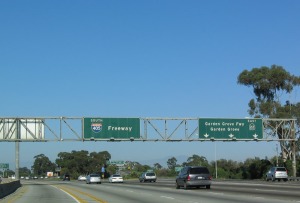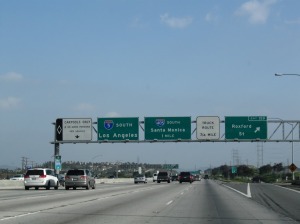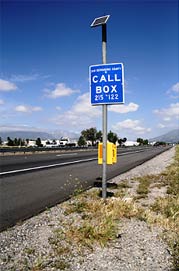For most of my life, I have always seen button copy signs on every freeway in Southern California. This was because the state of California and Caltrans used only use button copy signs on the freeways for many decades. Sadly, many of those signs are now gone for two reasons: First, most of those signs date back between the late 1950’s to the early 1970’s, which meant that many of those signs are at least 40 years and that they are showing a lot of wear and tear and second, according to Wikipedia, no company has produced new button copy signs since the early 2000’s or so. This means that all the old button copy signs on L.A.-area freeways will eventually be replaced with newer reflective freeway signs that are already used in just about other state. In addition, the new signs will also include exit numbers, as required by federal law; California long had a waiver for this requirement, but that was stuck down in the courts in 2001.
The old button copy signs meant a lot of memories to me. We often pass by those signs whenever we were going to just about anywhere. I also found that these signs have a historical story in them. Some of those signs have been changed numerous times. One example was that some old button copy signs have green plates to cover routes that no longer exists in the area, like U.S. 6, U.S. 395, CA-11(now CA/I-110) , or CA-7(now I-710). The 11 freeway became the 110 freeway in 1981 and the 7 freeway became the 710 freeway in 1984. In addition, most old freeway signs have the freeway name on it, but on newer signs, including later model button copy signs no longer mentions the freeway name and replaces it with the direction of the freeway (north, south, east, and west).
To put this into more detail, older button copy signs were initially made of steel, then switched to aluminum in 1985. The letters were made of porcelain and attached to the steel or aluminum body. Also, the shade of green used on California freeway signs were darker than those of other states, as well as newer freeway signs in California. Another unique aspect was that button copy freeway signs were supposed to last longer that conventional freeway signs (40 years, compared to usual 15 years) and reflector dots were added lettering to the signs because the signs themselves were not reflective; later button copy signs had those built-in. Lastly, the old freeway signs cost more to make than regular freeway signs.
Today, many Southern California freeways still have button copy signs, but most are now showing its age, especially the older steel ones. Some signs have rust in it, while others appears to be very dirty and hard to read, because the glue used in the signs ages after many years. Newer button copy signs, on the other hand is showing some warping and color changing. On some stretches of freeway in Los Angeles, the button copy signs are practically all but gone because of widening projects and/or the age of the signs and the newer reflective signs with exit numbers are now in place.
I predict that sooner or later, button copy signs will be thing of the past on L.A. freeways, just like call boxes, as mentioned in an earlier post. It is already a thing of the past elsewhere.
This site has more pictures of old button copy signs – some still there, some gone.
Special Thanks to: Daniel Faigin, Mike Ballard, and aaroads.com.



